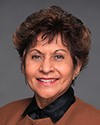I will answer part of that question. In terms of resources, I would recommend that you ask our coordinator, Clare Beckton, when you have the next chance to meet her.
I certainly can talk to you about the roles and responsibilities. It's not 15 people. The whole directorate is 15 people. That includes support staff. We are looking at 10 analysts as the core group of people who are working.
Really, the roles and responsibilities are now being defined for that directorate. It's a new directorate. As you know, it combined three former directorates from Status of Women Canada. We are endeavouring to do exactly what your question is going towards. It is to give the kind of support to the departments so that each analyst can be sort of like a chaperone or someone to help out the capacity level of different departments. There are about two or three departments, depending on the size of departments. When you're chaperoning HRSDC, it's a little bit bigger than chaperoning a smaller one such as DFAIT, as an example, in terms of size. Their role and responsibility is support. It's support in terms of capacity building. It's providing gender analysis on the different initiatives the departments choose to work on from a gender-based analysis perspective.
Some are already doing a lot of capacity building--not only the analysts but the departments--and don't need as much hand holding as other departments do.
As I mentioned last time, the Treasury Board submission requirement is creating, if you like, a demand for the services of Status of Women Canada.




